injury case consultation
Available 24/7
When the police are called to a motor vehicle accident (“MVA”), the officer writes a report using a standard form called a Kentucky Uniform Police Traffic Collision Report. The report will give the time and place of the accident, road conditions, and the weather, and will identify the vehicles, the drivers, and any other involved people.
The officer will also talk to the drivers and witnesses and prepare a narrative based on their statements. In this narrative, the vehicles will be identified as “Unit 1,” “Unit 2” and so on. Investigating officers will customarily designate the vehicle they think caused the accident as Unit 1, but this is not a legal determination of fault.
Insurance companies and lawyers use police collision reports to get the information they need to settle claims and resolve disputes around MVAs. In the next few blog posts, our injury lawyers in Lexington will go step-by-step through how to read a collision report.
For a typical accident involving two cars, the Kentucky Uniform Police Traffic Collision Report will consist of four or five pages. Here’s a sample from a real collision, with identifying information redacted:
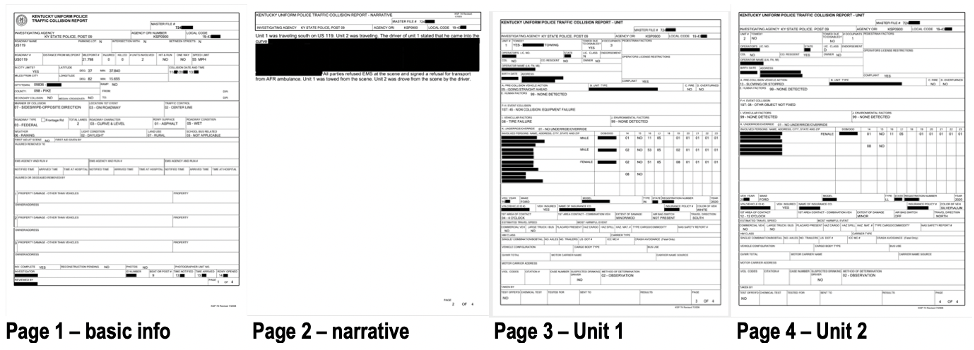
The first page contains the basics: when the collision occurred, where it happened, where the injured were sent, and which police department responded.
The second page will be the narrative prepared by the officer.
The next pages will give detailed information on units, with one page for each vehicle, beginning with Unit 1. Each will list the vehicle, who was driving, any passengers, the vehicle’s owner, insurance information, and so forth. Factors identified by the officer as contributing to the accident will be listed as well.
The listing on each unit page for the driver and passengers contains a special coded section that contains information about each person, such as position in the vehicle, whether they were wearing a seatbelt, and whether they were injured. To make sense of this section, you’ll need to refer to the code sheet. Don’t worry, the codes aren’t secret!
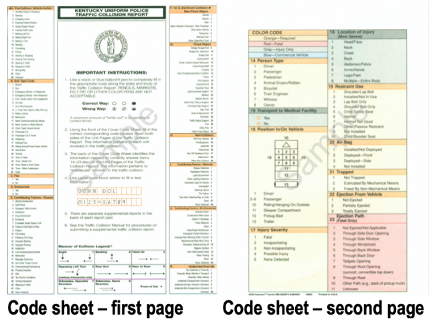
The National Highway Transportation Safety Administration has a downloadable copy of the Kentucky code sheet here. It’s useful to have one of these in front of you when you go over an accident report.
Sometimes the investigator will create a diagram of the accident and that will have its own page.
The first page of the Kentucky Uniform Police Traffic Collision Report contains basic information: when the collision occurred, where it happened, where the injured were sent, whether there was property damage other than to the involved vehicles, and which police department responded.
The top and bottom of the first page help you identify the report and who prepared it. The agency is listed along with the report’s file number at the top, while the bottom has the name of the investigating officer and his or her ID number, the name of the officer who reviewed the report, and information about any photos taken of the scene. Here’s the top of the page:

And here’s the bottom:

If the accident results in a lawsuit, the investigating officer may be asked about his or her recollections of the scene. Photos are often taken after major accidents. As lawyers, we’ll file an Open Records request to get copies of any photos taken.
In some circumstances, particularly where there has been a death, the police will have an accident reconstructionist examine the scene and write a separate report. Again, if the case is likely to result in litigation we’ll obtain the reconstructionist’s report as part of our investigation.
The information on when and where the accident occurred is found in the top half of the first page of the Kentucky Uniform Police Traffic Collision Report, just below the name of the investigating agency:
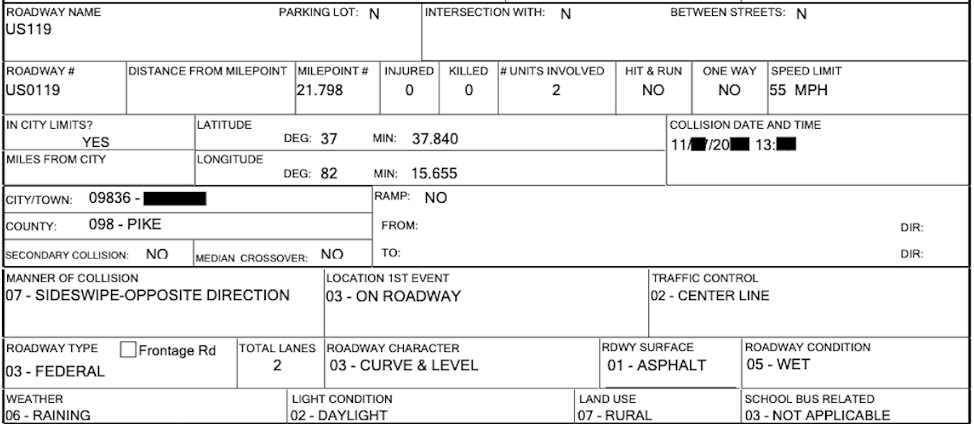
In this example, we see the accident occurred at about mile point 21.8 on U.S. Route 119 in Pike County. The latitude and longitude can be helpful to locate the place if you have Google Earth or a similar application.
We also see the accident occurred in daylight but in the rain on a curved and level stretch of a two-lane federal asphalt highway with a center line. Two units were involved and it was not a hit-and-run.
The trooper here put down that no one was injured or killed. Often, however, people are hurt in ways that are not immediately obvious at the accident scene. That’s why it’s important to get checked out by a doctor after an accident.
If there had been any treatment given at the scene or anyone transported to a hospital, that would be set out in this part of the first page:

Finally, the first page contains spaces to list damage to property other than the involved vehicles. In our case, there was no non-vehicle property damage, but in other instances might be mailboxes, fences, or even livestock:

The second page of the Kentucky Uniform Police Traffic Collision Report contains the narrative created by the investigating officer.
The officer will talk to each driver separately, usually at the scene but sometimes will visit an injured party at the hospital. The officer may also locate and talk to witnesses, particularly if the drivers give different accounts of what happened.
In this narrative, the vehicles will be identified as “Unit 1,” “Unit 2” and so on. Investigating officers will often designate the vehicle they think caused the accident as Unit 1, but this is not a legal determination of fault.
The goal of the narrative is not to give a final judgment as to what happened but to provide a record of what the drivers and witnesses reported and what occurred during the investigation.
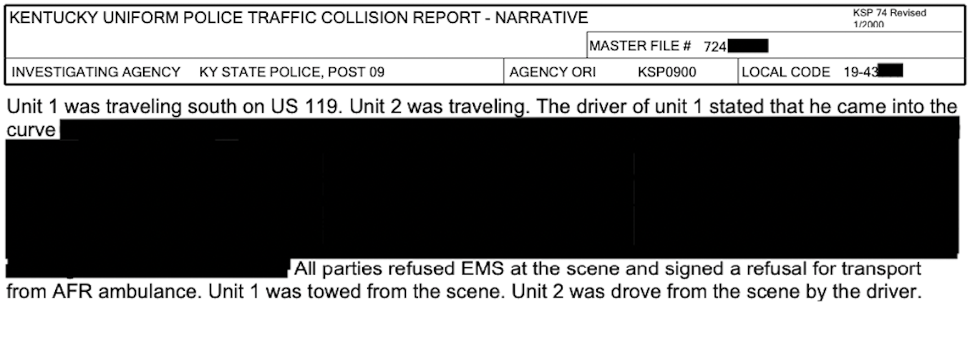
In this sample, the narrative starts with each unit’s initial position and then states what the driver of each vehicle said happened. Here, an ambulance responded to the scene, but neither party wanted to be taken to the hospital. Finally, we find out what happened to each vehicle after the accident: one was towed and the other drove away.
Sometimes the officer will prepare a basic sketch of what happened based on the narrative. There wasn’t one in this sample report, but if there it will be attached as its page.
The third and fourth pages of the Kentucky Uniform Police Traffic Collision Report we’re using as a sample contains detailed information on units, with one page for each vehicle, beginning with Unit 1. Each will list the vehicle, who was driving, any passengers, the vehicle’s owner, insurance information, and so forth. Factors identified by the officer as contributing to the accident will be listed as well.
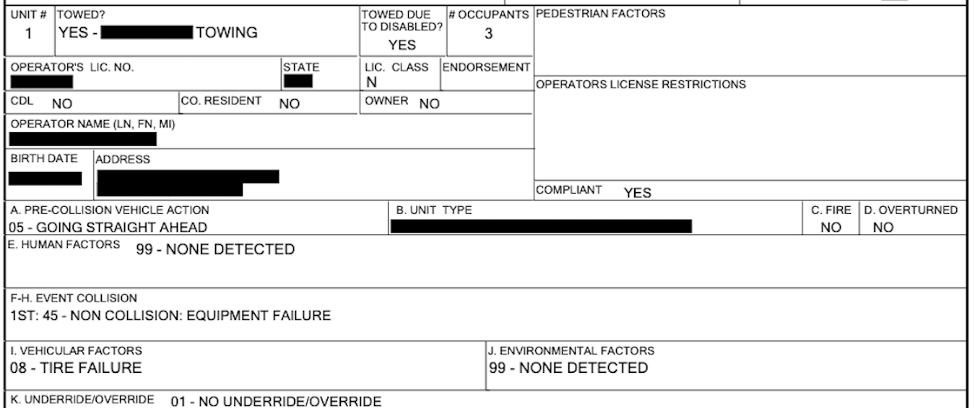
In our sample, we see Unit 1’s operator identified by name, birthdate, address, and driver’s license number. The vehicle had three occupants and was proceeding straight ahead when there was a tire failure that led to the accident. Thankfully, the vehicle did not catch fire and did not overturn.
Lower down the page you’ll find a lot of details about the vehicle, including a description by make, model, model year, and the assigned numbers for the the VIN and the registration. The insurance carrier and policy number are listed here as well, information crucial to making a claim!
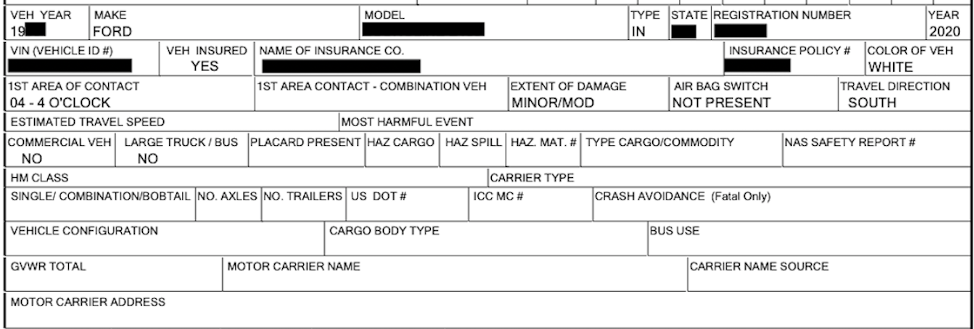
This is also where the investigating officer will record the first area of impact, the vehicle’s travel direction, and the extent of damage. If the unit is a commercial vehicle, the officer has a lot more information to include! Commercial vehicles are regulated at the state and federal levels and this information is used to meet government reporting requirements.
If the officer gives the operator of this unit a citation for DUI or another violation, complete information will be included at the bottom of the page:

In our sample, the driver of Unit 1 was not given a citation.
Each additional vehicle involved will be designated Unit 2, then Unit 3, and so on. These same designations will be used in the narrative portion of the police report.
Finally, the unit page also contains a special coded section that contains information about each person associated with the vehicle. In the next post, we’ll look at how to read that section for each involved unit using Kentucky’s code sheet.
Police officers use a two-page code sheet with instructions to help them prepare each Kentucky Uniform Police Traffic Collision Report.
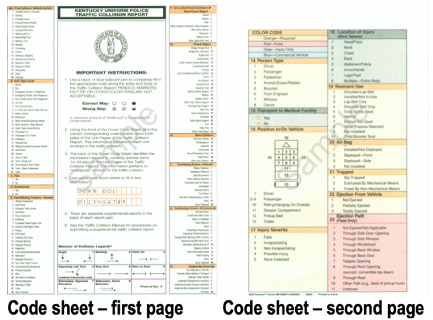
The National Highway Transportation Safety Administration has a downloadable copy of the full Kentucky code sheet here.
We’ve already taken a look at the unit pages of the police report. These contain detailed information with one page for each vehicle, beginning with Unit 1. Each lists the vehicle, who was driving, any passengers, the vehicle’s owner, insurance information, and so forth.
In the middle of the page for each unit, you’ll find a special coded section that contains detailed information about each associated person, such as position in the vehicle, whether they were wearing a seatbelt, and whether they were injured.
Here’s that portion from our sample:

In this case, the first person listed is Unit 1’s driver, then the two passengers. We can find out more about these persons using the second page of the code sheet used by Kentucky’s law enforcement officers. Here’s a closer look at the code sheet’s second page:
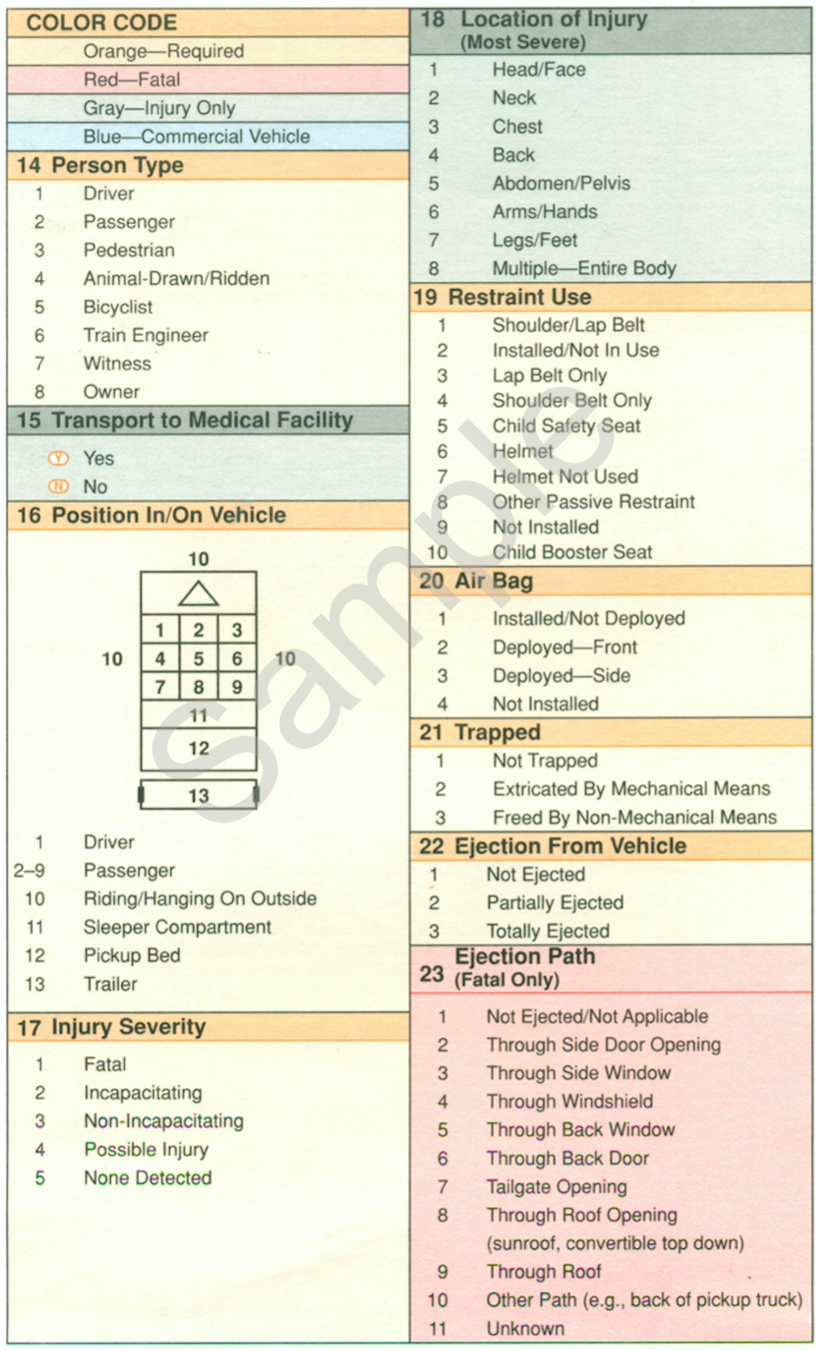
From this, we can see that the driver (box 14, code 1) was not transported to a medical facility, had no detected injury, was using a shoulder/lap belt, was not trapped nor ejected, and the vehicle was equipped with an airbag that did not deploy. (Note the officer’s entries for box 16, position on the vehicle, each seems to have an unexplained extra digit. That’s something that would be clarified with an interview or deposition of the investigating officer.)
The bottom row lists the vehicle’s owner, designated with the “08” code in box 14. The owner could be a person, a company, or a government entity. If the owner was not in the vehicle, then the remaining boxes in that row won’t be filled out.
By using these codes, a large amount of information about each occupant of the vehicle can be included in a small space on the police report.
If you’ve been in an accident and think you have a claim, please contact us by calling (800) 337-4002 for a free consultation and set up an appointment with a Lexington car accident attorney. If you have your police report, please bring it along to your meeting – it will help evaluate your case!
This is a blog post, not specific legal advice. No attorney-client relationship is intended or created.